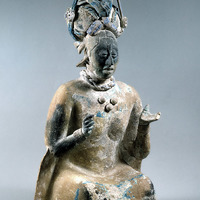-
Identifier
-
TP.2022.J.06
-
title
-
Figurine of a Seated Female
-
name
-
Unknown
-
date created
-
ca. 650–800 CE
-
area
-
16.4 x 9.3 x 7 in (41.6 x 23.5 x 17.8 cm)
-
description
-
"This figurine of a seated female is extraordinary both for its size and surviving pigments. The work measures 41.7 centimeters tall, which is three to four times larger than most other Classic-period Maya ceramic figurines, but its depiction of a seated female wearing a huipil, a garment worn by ancient and present-day Maya women, is common among Jaina-style figurines. Like the smaller examples, this object served as a whistle, with the mouth hole in the bottom of the figurine. It may once have been deposited in the tomb of an elite individual—along with other figurines, ceramic vessels, and jades—in a context similar to figurines excavated on Jaina Island or at sites such as Palenque.
The hollow body was made in a mold, with added hand-modeled elements, including the necklace, which was appliquéd onto her chest, and her forearms. Her arms are elegantly positioned, with the forearms projecting upward. Her hands curve gracefully, and the fingernails, joints, and flesh of the palms and fingers are delicately articulated. The position of the hands suggests that they once held something. On her wrists, gridlike incisions simulate mosaic wrist cuffs of cut shell or jade.
Like many other Jaina-style figurines, the head is mold made. Her face is a narrow oval, and her facial features—particularly nose and lips—are drawn forward, creating a distinct, striking profile when viewed from the side. The still-soft clay was modified after it was removed from the mold, and the artist added facial adornments, including beads on the nose and chin and slits in the upper and lower lips, to represent cicatrization. The shape of this head also reflects the custom of cranial modification. Her hair is parted in the middle and steps down the side of her face in a style common on women in Classic Maya art. Her complex headdress is formed of hand-modeled elements and is painted with Maya blue. The headdress is made of bundles adorned with rows of pressed ovals alternating with incised diagonal lines that together convey the texture of woven cloth. Braids wrap around those bundles, both as adornment and as if to hold them in place. The attached flowers on the headdress are modern additions.
After modeling and firing the clay, the artist painted it with brilliant hues of yellow, red, and blue, although the object’s current condition offers only a hint of what would have been a dazzling palette. Her huipil is yellow, a color commonly used for painting the garments of Jaina-style figurines. Most likely made of limonite, which produced yellow ochre, the hue survives in large areas across the front of the body and in small flecks on the back and side flanges. Small areas of red pigment—likely from hematite— remain on her neck, shoulder, ear, and hair, thus indicating that her skin was once painted this deep red.
There also are at least two shades of Maya blue on the figurine: an azure shade used to trim her garments and a sky blue on her skin. The azure was applied to her headdress, coloring the braided bands that wrap each bundle. It also was painted in sharply defined bands, one across her knees and the other around her neck, to form a four-sided stepped pattern that is frequently seen on Maya women’s garments even today. The sky-blue color survives on her face, neck, hair, arms, hands, and skirt, but without any apparent pattern. There are modern blue pigments on the figurine, including blue paint on the headdress. The restorer applied this paint only in segments, perhaps to convey an aged look, but it does not resemble the hue or surface texture of the Maya blue pigment on the rest of the figurine.
Portrayals of women are common in Jaina-style figurines. Females are shown seated, with legs crossed, backs straight, and arms resting on their knees or with one or both hands raised in a gesture. The women wear huipils and are often adorned with necklaces, earflares, and wrist cuffs. In contrast to the Dumbarton Oaks figurine, females are more commonly depicted without headdresses."
—Dumbarton Oaks
-
Access Rights
-
Dumbarton Oaks.
 TP-2022-J-06
TP-2022-J-06
